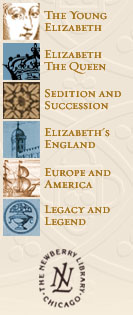 |

The Execution of Mary Queen of Scots

Parliament vehemently called for the death of Mary Queen of Scots in 1572 because of her involvement in the Duke of Norfolk's plot against Elizabeth, but Elizabeth refused to allow the execution of a sister queen. In 1586, secret plans were developed to murder Elizabeth and place the Scottish queen on the throne. When Mary joined the conspiracy, Elizabeth's spies intercepted her letters, and Mary was tried and condemned.
Even with this evidence, Elizabeth was reluctant to order Mary's execution. At last, in February 1587, she signed a death warrant. Her advisors immediately sent the order to Fotheringay Castle, where Mary was beheaded the next day. Later, Elizabeth claimed that she had not meant for the sentence to be carried out, and tried to distance herself from the international outrage that followed. While English Protestants celebrated Mary's death, she was portrayed in France and Spain as a martyr to the Catholic faith.
Image second from the left copyright of the British Library and further reproduction is prohibited
Return to Sedition and Succession
|  |



